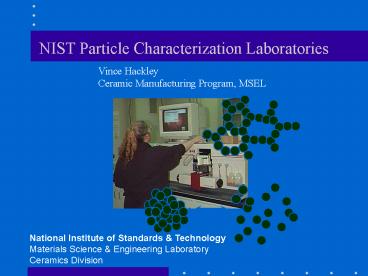NIST Particle Characterization Laboratories PowerPoint PPT Presentation
1 / 12
Title: NIST Particle Characterization Laboratories
1
NIST Particle Characterization Laboratories
Vince Hackley Ceramic Manufacturing Program, MSEL
National Institute of Standards
Technology Materials Science Engineering
Laboratory Ceramics Division
2
Ceramic Materials
Ceramics non-metallic inorganic materials
Structural Electronic Refractory Bioceramic Struct
ural Clay White Wares Cement
3
Ceramic Manufacturing
Ceramic manufacturing can involve a number of
complex processes, each of which is impacted by
the previous step.
4
Particulates in Ceramic Processing
Vince Hackley
Vince Hackley
Vince Hackley
Vince Hackley
- The vast majority of ceramics are manufactured
starting from powders - Wet processing (dispersion) is widely used in
industry - Particle characteristics have a profound impact
on the properties of consolidated ceramics
5
Particulate Properties
Particle characterization is a key enabler for
reliable cost-effective manufacture of advanced
ceramics
Physical Properties
Dispersion Properties
- Density
- Porosity
- Surface Area
- Shape
- Size Distribution
- Surface Charge
- Zeta Potential
- Surface Chemistry
- Rheology
- Agglomeration
6
Ultrasonic Measurement Methods
The most important feature of ultrasonics is its
capacity to provide useful information on
concentrated suspensions
- Advantages
- concentrated systems
- non-destructive
- robust sensors
- during flow
- rapid
- high precision
- Properties
- particle size distribution
- zeta potential
- solids concentration
7
Zeta Potential
Zeta potential
shear plane
diffuse layer
8
Measuring Zeta Potential
Zeta is typically measured using electrokinetic
methods In an electric field, charged particles
will move with a velocity dependant on Zeta and
the applied field
9
Electroacoustic Measurements
Based on the coupling between electric and
acoustic fields in a suspension of charged
particles
electric field
pressure
ESA CVP CVI
transducer output signal
input potential
10
Cement Hydration
CVP Measurements Provide Information on Cement
Particle Chemistry
Relative Acoustic Mobility (RAM) of Portland
cement as a function of hydration time and solids
loading. Reflects physical and chemical changes
that impact the cement particles. Flatt
Ferraris (unpublished)
11
Conclusion
- The Ceramic Manufacturing Program at NIST has
- world class laboratories for the
characterization of fine particles - expertise in working with inorganic particulates
- unique ultrasonics facility for characterizing
concentrated suspensions
12
Available Instrumentation
- AMRAY 1830 SEM
- Beckman J2-HC Centrifuge
- Brookfield DVII Viscometer
- Colloidal Dynamics Acoustosizer
- Coulter LS230 Laser Diffraction
- Coulter Multisizer II Zone Sensing
- Dispersion Technology DT1200 Acoustic
Spectrometer - Horiba LA900 Laser Diffraction
- Micromeritics Sedigraph 5100
- Micromeritics AccuPyc 1330
- Malvern Zetasizer 3000HS Doppler Laser Scattering
- Matec ESA8000 Electroacoustic Analyzer
- Perkin-Elmer 330 UV-VIS Spectrophotometer
- Quantachrome AUTOSORB-1 Multipoint Gas Adsorption
- Quantachrome AUTOSORB-60 Mercury Porosimeter
- Rheometrics RS2000 Rheometer
- Rosemount-Dohrmann DC80 TOC

